Embark on a fascinating journey through the Sunflower State as we explore the diverse range of blue birds that call Kansas home. From the melodious Eastern Bluebird to the striking Indigo Bunting, our free photo guide will introduce you to the vibrant world of blue birds found across the state.
Whether you are a seasoned bird watcher or a beginner looking to start, this guide will serve as your essential companion for birdwatching adventures in Kansas.
Blue Birds Found In Kansas
The wide variety of habitats found in Kansas makes it a haven for a diverse range of bird species. The state’s central location also makes it a critical stopover point for migratory birds traveling between their breeding and wintering grounds. From the tallgrass prairies in the east to the high plains in the west, the different ecosystems across the state provide suitable habitats for many bird species, including a variety of blue birds.
The numerous rivers, lakes, and wetlands scattered across Kansas offer vital water sources and feeding grounds, attracting an even broader array of birdlife.
Barn Swallow


| Feature | Measurement |
|---|---|
| Scientific Name | Hirundo rustica |
| Length | 6.5–7.5 in |
| Wingspan | 12.5–13.5 in |
| Weight | 16–22 g |
The Barn Swallow is a sleek, agile bird renowned for its graceful flight patterns and iconic forked tail, often seen darting over fields and water bodies in search of flying insects.
Appearance: Barn Swallows have deep blue, almost iridescent, upperparts and a rufous to tawny underbelly. Their distinctively forked tail and long wings give them a streamlined look. Both males and females have a similar appearance, though males often exhibit slightly brighter colors and a deeper fork in the tail.
Diet: Barn Swallows feed primarily on flying insects, which they catch in mid-air during their agile and acrobatic flights. Their diet includes flies, beetles, moths, and other small flying insects.
Reproduction: Barn Swallows are known for building their mud nests on man-made structures, particularly barns, bridges, and eaves. The nest is cup-shaped and made from mud pellets, often lined with feathers. The female lays a clutch of 4 to 6 eggs.
Blue Grosbeak
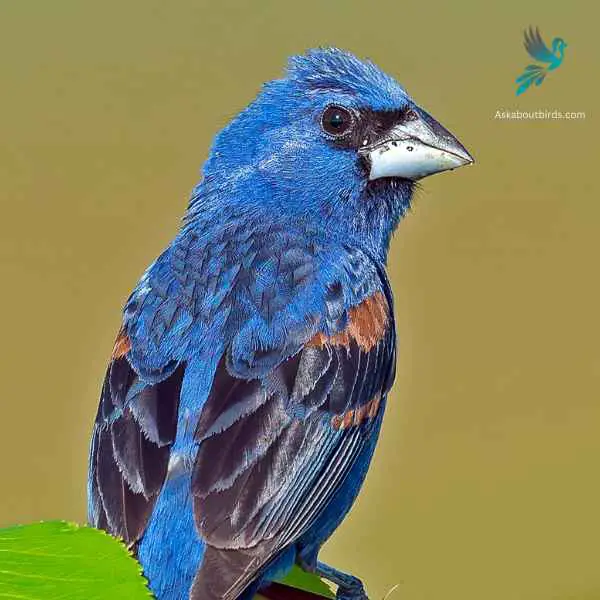

| Feature | Measurement |
|---|---|
| Scientific Name | Passerina caerulea |
| Length | 5.5 to 7.5 in |
| Wingspan | 10 to 11 in |
| Weight | 26 to 31.5 g |
The Blue Grosbeak is a medium-sized songbird found in North and Central America. The male Blue Grosbeak displays stunning plumage with deep blue feathers on its body and head, while the female has more subdued brownish tones. Both sexes have a thick, conical bill, which gives them their name “grosbeak,” meaning large beak.
These birds prefer open habitats such as grasslands, brushy areas, and woodland edges. Blue Grosbeaks are known for their melodious songs, which consist of a series of rich and varied notes. They primarily feed on seeds and insects, using their strong beaks to crack open seeds and forage on the ground or in low vegetation.
Belted Kingfisher

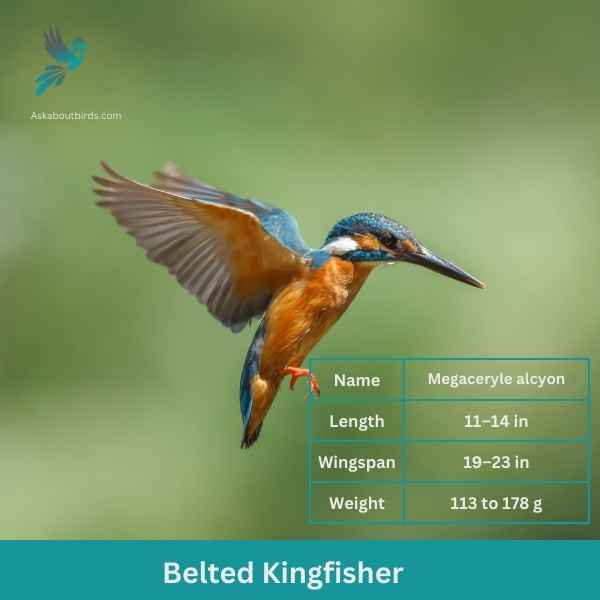
| Feature | Measurement |
|---|---|
| Scientific Name | Megaceryle alcyon |
| Length | 11–14 in |
| Wingspan | 19–23 in |
| Weight | 113 to 178 g |
The Belted Kingfisher is a distinctive and easily recognizable bird, frequently observed near water bodies, where it can be seen diving headfirst to catch prey.
Appearance: Sporting a prominent crest, the Belted Kingfisher has a slate blue-gray upper body and white underparts. Males possess a single blue band across their white chests, while females have an additional rufous band, making them one of the few bird species where females are more brightly colored than males. Their bill is long, sharp, and dagger-like.
Diet: As expert fishers, Belted Kingfishers mainly prey on small fish, but they’ll also consume crustaceans, insects, and amphibians. They’re known for their hunting tactic of hovering over water, spotting their prey, and then diving swiftly to snatch it.
Reproduction: Belted Kingfishers nest in burrows which they excavate in sandy or earthen banks, usually adjacent to water. The tunnel can be anywhere from 3 to 6 feet long, ending in a chamber. Within this chamber, the female lays a clutch of 5 to 8 white eggs.
Tree Swallow
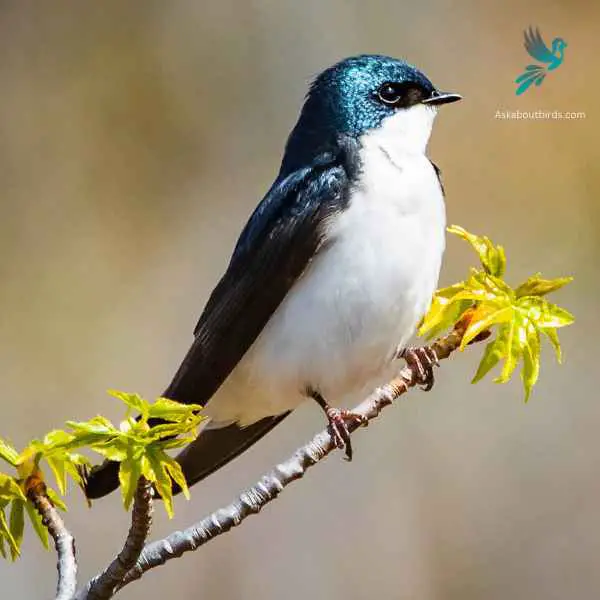
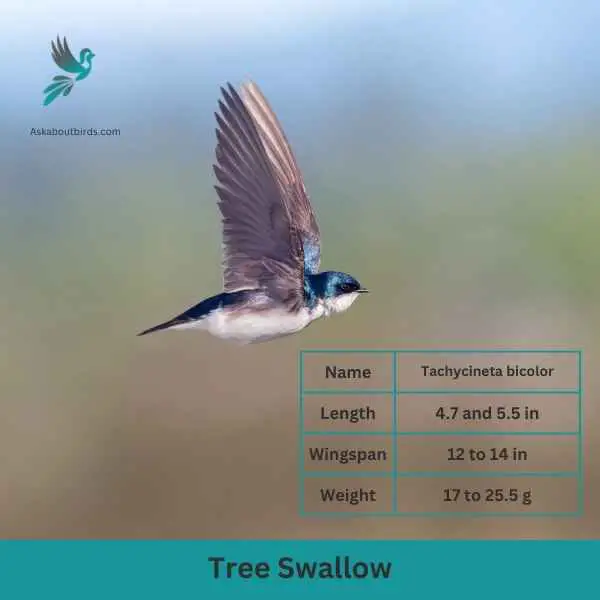
| Feature | Measurement |
|---|---|
| Scientific Name | Tachycineta bicolor |
| Length | 4.7 and 5.5 in |
| Wingspan | 12 to 14 in |
| Weight | 17 to 25.5 g |
The Tree Swallow is a graceful and agile bird, best recognized for its iridescent blue-green upperparts and sweeping flight patterns over open fields and water.
Appearance: The Tree Swallow is sleek with a streamlined body. The upperparts shine with a blue-green iridescence while the underparts are white. They possess long, pointed wings and a slightly forked tail, aiding in their agile flight.
Diet: Tree Swallows primarily feed on flying insects, skillfully catching them mid-air. During colder months when insects are scarce, they can switch to a diet of berries, particularly those of the bayberry, which other birds might find hard to digest.
Reproduction: Tree Swallows are cavity-nesters, typically choosing natural holes in trees or using bird boxes. They line their nests with feathers, creating a soft environment for the eggs. The female will lay a clutch of 4 to 7 white eggs.
Eastern Bluebird
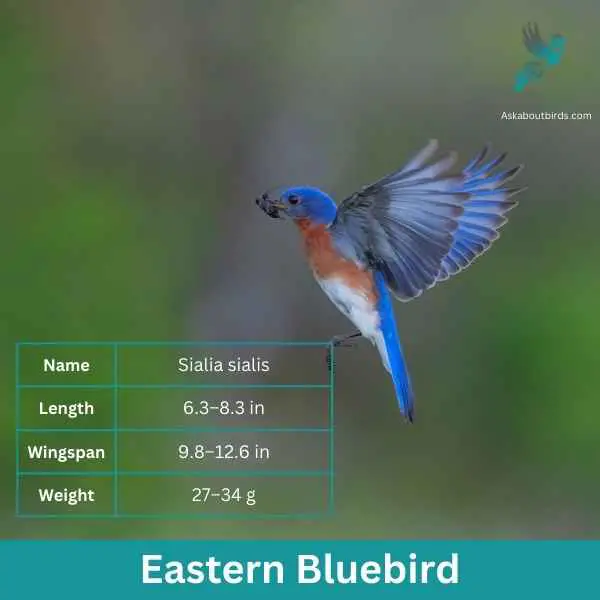
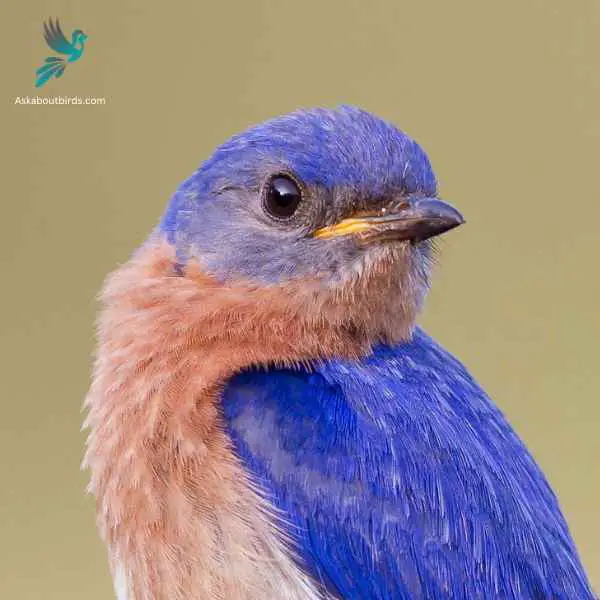
| Feature | Measurement |
|---|---|
| Scientific Name | Sialia sialis |
| Length | 6.3–8.3 in |
| Wingspan | 9.8–12.6 in |
| Weight | 27–34 g |
The Eastern Bluebird (Sialia sialis) is a small thrush found in open woodlands, farmlands, and orchards, and is recognized for its vibrant blue and red coloration. Male Eastern Bluebirds are dazzling with bright blue upperparts and a rusty or brick-red throat and breast, while females, though less colorful, still offer a similar pattern. The bird is native to North America and is commonly seen east of the Rockies, from Canada to the Gulf States and southeastern Arizona to Nicaragua.
Eastern Bluebirds feed on insects, wild fruit and berries. They have a gentle nature and are often seen perched alone or in small groups in the open, scanning the ground for prey. They are cavity nesters and will use old woodpecker holes or birdhouses if they are the right size.
Purple Martin
Mountain Bluebird
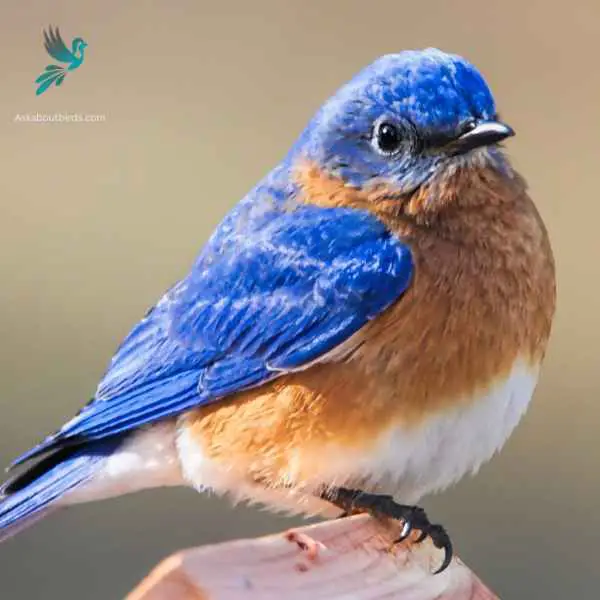
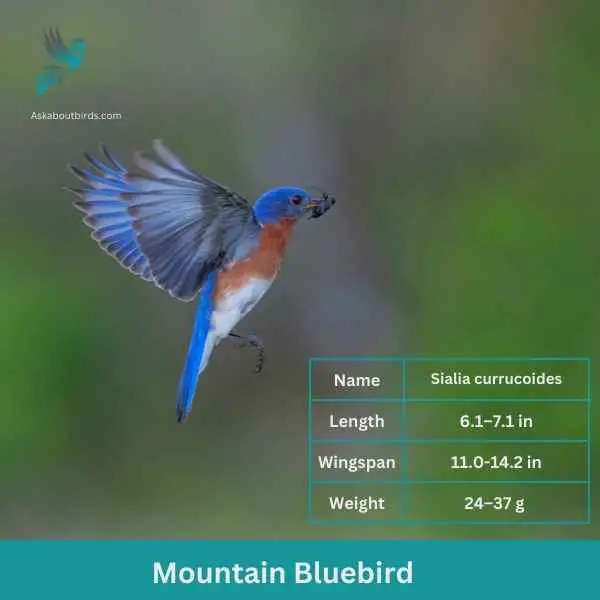
| Feature | Measurement |
|---|---|
| Scientific Name | Sialia currucoides |
| Length | 6.1–7.1 in |
| Wingspan | 11.0-14.2 in |
| Weight | 24–37 g |
The Mountain Bluebird is a small bird found in open grasslands and rocky mountains of North America. It is known for its stunning blue plumage, which is particularly vibrant in males. Females, on the other hand, have a more subdued blue coloration with hints of gray. These birds have slender bodies and a slightly curved bill, adapted for catching insects on the wing.
Mountain Bluebirds are insectivores, feeding primarily on insects such as beetles, grasshoppers, and spiders. They are skilled aerial hunters, capable of capturing their prey in mid-flight. During breeding season, these birds build their nests in tree cavities or man-made nest boxes, where females lay a clutch of eggs. The male bluebird actively participates in nest-building and provides food for the female during incubation.
Cerulean Warbler
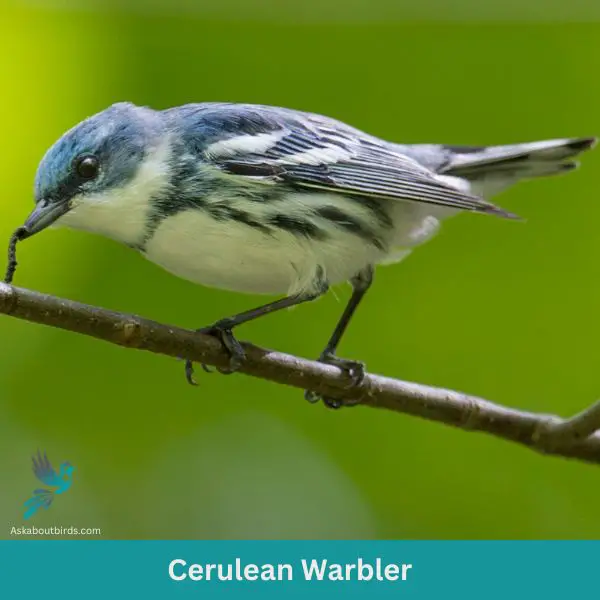
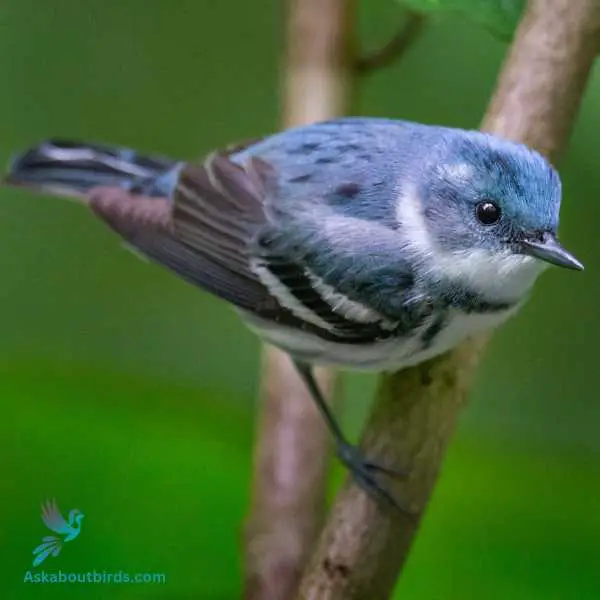
| Trait | Cerulean Warbler |
|---|---|
| Scientific Name | Setophaga cerulea |
| Length | 4.5 inches |
| Wingspan | 7.9-8.7 inches |
| Weight | 0.3-0.4 ounces |
The Cerulean Warbler is a striking songbird known for its sky-blue plumage and flitting movements in the forest canopy.
Appearance: Males boast a vibrant cerulean blue color on their upperparts, with streaked underparts, and a black necklace. Females have a more subdued bluish-green hue and lack the prominent black markings seen in males.
Diet: The diet of the Cerulean Warbler is predominantly made up of insects and spiders. They actively forage high in the treetops, gracefully maneuvering through leaves and branches.
Reproduction: Cerulean Warblers nest in the upper branches of tall deciduous trees. The female weaves a shallow cup-shaped nest and lays a clutch of 3-5 eggs.
Western Bluebird
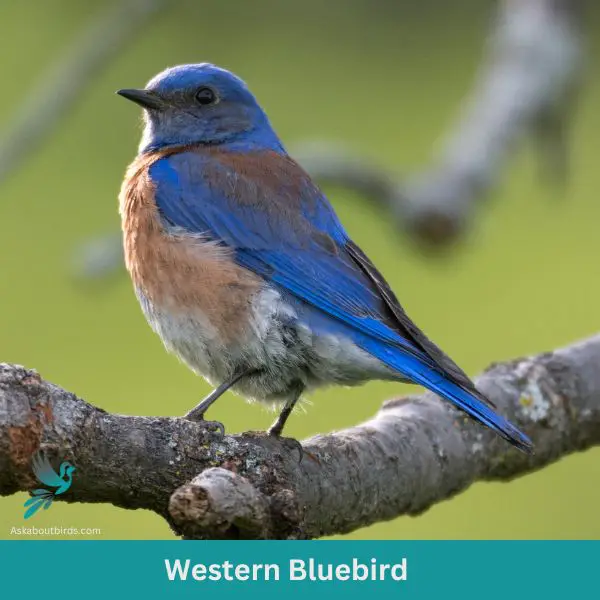
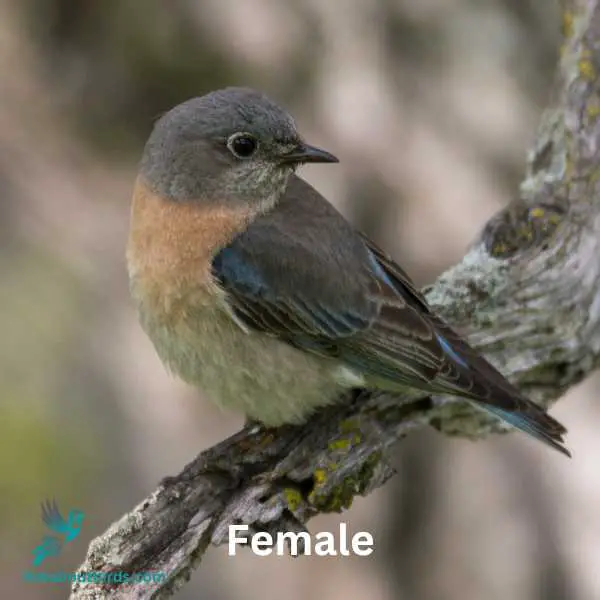
| Trait | Western Bluebird |
|---|---|
| Scientific Name | Sialia mexicana |
| Length | 5.5-7 inches |
| Wingspan | 11-13 inches |
| Weight | 0.8-1.1 ounces |
The Western Bluebird is a charismatic bird, appreciated for its vivid coloring and melodious song, commonly observed in open woodlands and meadows of the West.
Appearance: The male Western Bluebird sports a dark blue head, throat, wings, and tail with an orange breast and sides, transitioning into a grayish belly. Females are more muted, displaying grayish-blue wings and tail with a more subdued orange wash on the chest.
Diet: Western Bluebirds predominantly feed on insects, complemented by berries and fruits when available. They hunt by perching and then diving to the ground to capture their prey, and they’re also known to catch insects in mid-air.
Reproduction: These birds often utilize natural tree cavities or nest boxes for breeding. The female builds a loose nest inside and lays a clutch of 4-6 pale blue eggs.
Blue Jay

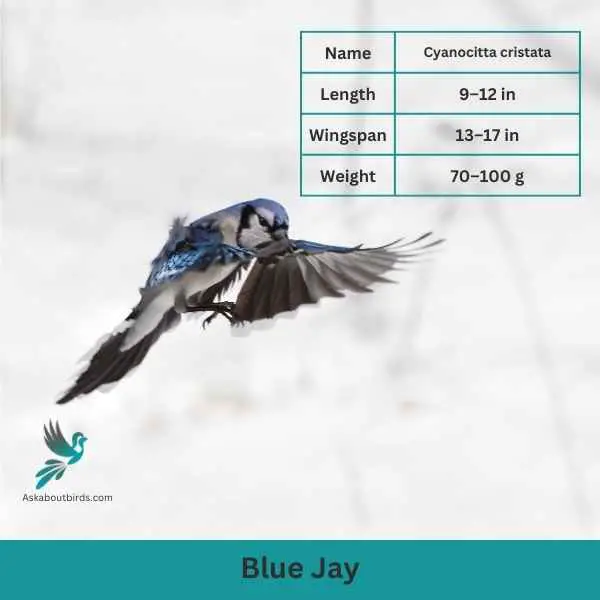
| Feature | Measurement |
|---|---|
| Scientific Name | Cyanocitta cristata |
| Length | 9–12 in |
| Wingspan | 13–17 in |
| Weight | 70–100 g |
The Blue Jay is a vibrant and easily recognized bird, known for its intelligence, distinctive calls, and bold behavior, commonly found throughout the eastern and central United States.
Appearance: The Blue Jay sports a striking blue upper body with white and black markings. Its face has a pronounced white patch with a black necklace that runs across the throat and around the head. The bird also features a pronounced blue crest, which can be raised or lowered, and its wings and tail are brightly colored with black bars and white tips.
Diet: Blue Jays are omnivores. Their diet consists primarily of seeds, nuts, especially acorns, fruits, and small insects. They’ve also been known to eat eggs or nestlings of other birds occasionally. Blue Jays often store food items in caches to eat later.
Reproduction: Blue Jays are monogamous birds that form long-lasting pair bonds. They typically build their nests in trees or large shrubs, constructing them from twigs, grass, and sometimes using mud as a binder. The female lays a clutch of 3 to 6 eggs, which are pale blue or sometimes white with brown speckles.
Indigo Bunting


| Feature | Measurement |
|---|---|
| Scientific Name | Passerina cyanea |
| Length | 4.5–5.1 in |
| Wingspan | 7.1–9.1 in |
| Weight | 11.2–21.4 g |
The Indigo Bunting is a strikingly vibrant songbird, often hailed for its brilliant blue plumage and melodic song that graces woodlands and meadows during the warmer months.
Appearance: Males are renowned for their bright indigo blue feathers, which can appear darker in certain lights. Females and juveniles, on the other hand, are brown with subtle hints of blue on their wings and tail. The species lacks the vibrant streaking or spotting commonly found in many other songbirds.
Diet: Indigo Buntings primarily subsist on seeds, especially during non-breeding seasons. During the breeding season, they also consume a variety of insects such as beetles, caterpillars, and spiders, providing essential protein for their growing chicks.
Reproduction: Indigo Buntings build their nests close to the ground in shrubs or low tree branches. These nests, crafted meticulously with grasses and other plant materials, cradle clutches of typically 3 to 4 eggs. After hatching, the young are fed by both parents until they’re ready to fledge.
Blue Grosbeak


| Feature | Measurement |
|---|---|
| Scientific Name | Passerina caerulea |
| Length | 5.5 to 7.5 in |
| Wingspan | 10 to 11 in |
| Weight | 26 to 31.5 g |
The Blue Grosbeak is a medium-sized songbird found in North and Central America. The male Blue Grosbeak displays stunning plumage with deep blue feathers on its body and head, while the female has more subdued brownish tones. Both sexes have a thick, conical bill, which gives them their name “grosbeak,” meaning large beak.
These birds prefer open habitats such as grasslands, brushy areas, and woodland edges. Blue Grosbeaks are known for their melodious songs, which consist of a series of rich and varied notes. They primarily feed on seeds and insects, using their strong beaks to crack open seeds and forage on the ground or in low vegetation.
Where to Spot Kansas’ Blue Birds
Kansas is a treasure trove for bird watchers, with a range of habitats that attract a diverse array of bird species, including the beloved blue birds. Here are some of the top locations in Kansas known for their great diversity of birds:
- Cheyenne Bottoms Wildlife Area: This is one of the most important shorebird migration stopover points in the Western Hemisphere. It is home to more than 340 bird species, including various species of blue birds.
- Quivira National Wildlife Refuge: Located in central Kansas, this refuge is a mix of salt marshes, sand dunes, and prairies, making it a habitat for a diverse range of bird species, including several species of blue birds.
- Milford Nature Center and Fish Hatchery: Located near Junction City, this area is home to a variety of habitats, from woodlands to wetlands, attracting a wide array of bird species, including blue birds.
- Flint Hills: This region is the last remaining expanse of tallgrass prairie in North America, and it hosts a variety of bird species, including the Eastern Bluebird and other birds with blue plumage.
- Cimarron National Grassland: Located in the southwestern corner of the state, this is the largest area of public land in Kansas and is home to a variety of bird species, including the Mountain Bluebird and other species with blue plumage.
| Neighboring States | Top Spots for Blue Birds |
|---|---|
| Nebraska’s Blue Birds | 1. Crescent Lake National Wildlife Refuge 2. Fontenelle Forest 3. Indian Cave State Park |
| Missouri’s Blue Birds | 1. Mingo National Wildlife Refuge 2. Riverlands Migratory Bird Sanctuary 3. Mark Twain National Forest |
| Oklahoma’s Blue Birds | 1. Wichita Mountains Wildlife Refuge 2. Sequoyah National Wildlife Refuge 3. Oxley Nature Center |
| Colorado’s Blue Birds | 1. Rocky Mountain National Park 2. Barr Lake State Park 3. San Juan National Forest |
FAQs on Blue Bird Species Found in Kansas
Why is the indigo bunting a popular bird for backyard birdwatchers?
The indigo bunting is one of the most popular birds among backyard birdwatchers due to its stunning appearance and pleasant songs. Sporting a royal blue plumage in the males and a bluish gray to brownish in the females, these blue beauties are a sight to behold. Furthermore, they often visit bird feeders, especially in the early spring, making it easier for enthusiasts to spot them. Additionally, indigo buntings are known to help control insect populations as they feed on insects during the nesting season, which is beneficial for your backyard. Remember to check the indigo bunting range map to see if they are commonly found in your area.
What is the impact of house sparrows on backyard birds?
House sparrows, although common visitors to bird feeders, can have a negative impact on other backyard birds. They are known to be aggressive and often outcompete native birds for food and nesting sites. For example, they have been known to take over nesting boxes intended for bluebird species, remove their eggs, and build their own nests instead. This behavior can lead to a decline in the population of native bird species. Therefore, it is important to monitor your bird feeders and nesting boxes regularly to ensure that house sparrows are not dominating the area.
Why is it necessary to clean bird feeders regularly?
Regular cleaning of bird feeders is essential to prevent the spread of diseases among wild birds. Feeders often accumulate waste, such as bird droppings, spoiled food, and mold, which can be harmful to birds. Moreover, damp seeds can develop fungal and bacterial growth, leading to illnesses like salmonellosis and aspergillosis. House sparrows and other common visitors to bird feeders can carry diseases, which may spread to other birds. By cleaning your bird feeder regularly, you ensure the safety and health of the birds visiting your backyard.
What can you do to attract more birds to your backyard?
To attract more birds to your backyard, provide a variety of food sources like sunflower seeds, whole peanuts, and suet. Install different types of bird feeders to accommodate various bird species. Provide fresh water by setting up a bird bath or a heated birdbath in the winter months. Plant native trees and shrubs that provide natural food and shelter. Create nesting sites by putting up nest boxes suitable for different bird species. Lastly, keep predators like cats and rodents away from your backyard and maintain a safe environment for the birds.
